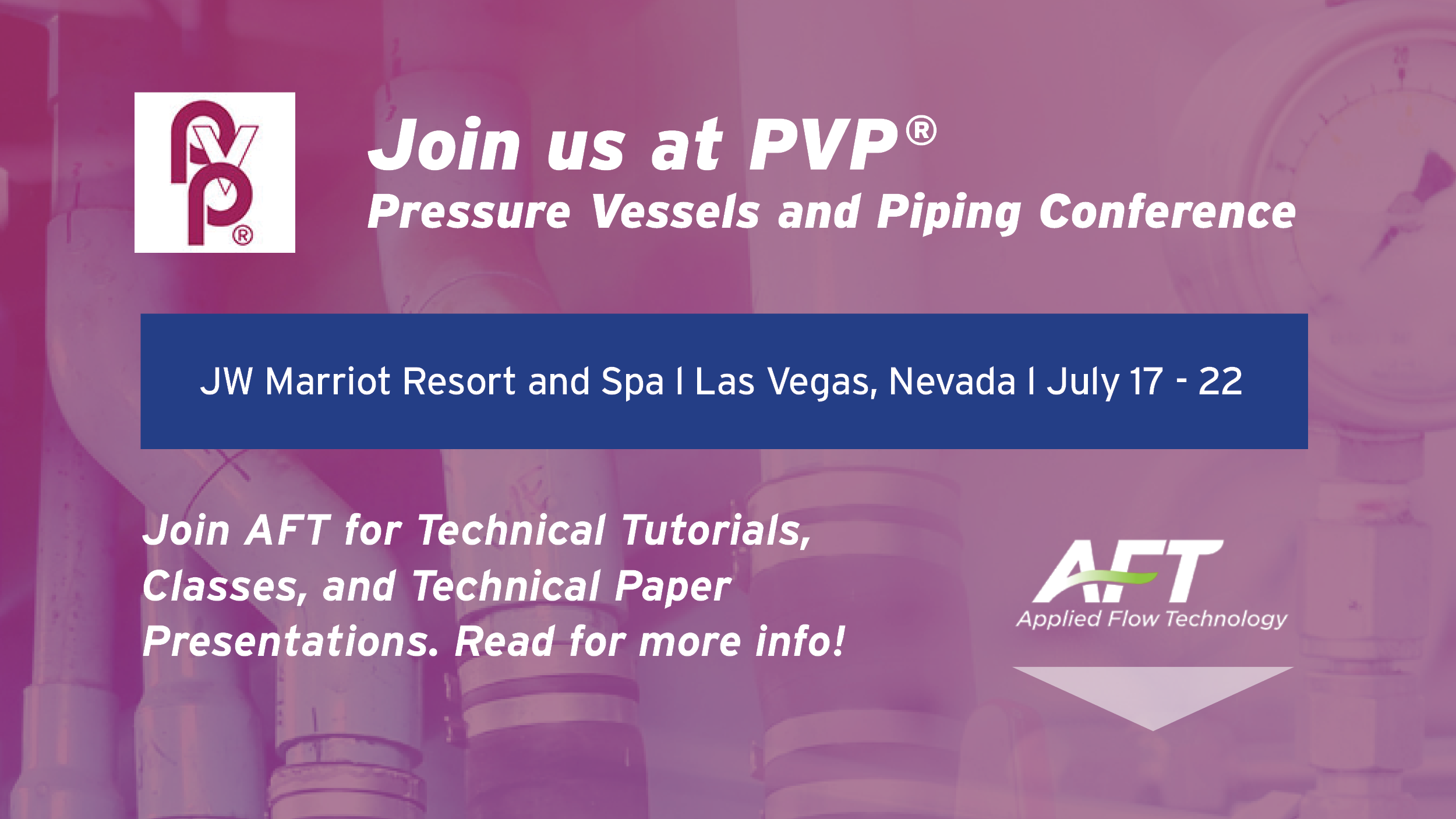
ASME PVP Pressure Vessels & Piping Conference
Colorado Springs, CO, USA - July 11, 2022 - Applied Flow Technology (AFT) plans to present not one, but four Technical Papers as well as a Tutorial during the 2022 ASME PVP conference in Las Vegas, Nevada, USA.
AFT President & Founder, and ASME Fellow, Trey Walters, PE will be presenting his Tutorial along with two technical papers relating to Steam Hammer in power station piping. AFT Sr. Engineering Software Developer, Scott Lang, PE will also be presenting two technical papers on the fundamentals and applications of predicting transient fluid forces in piping systems. See the detailed topics and presentation times/locations below.
AFT has been an active participant in the ASME PVP conference for many years. However this year AFT is taking a more active role with Walters serving as the conference Technical Program Representative (TPR) for the Fluid-Structure Interaction (FSI) track. This means Walters is responsible for organizing the FSI paper submissions and overseeing independent referee paper reviews.
If you plan to attend, look for AFT's tabletop display and say hello to Walt Prentice, who will be attending to answer questions and teach engineers how they can use AFT software to calculate pressures and flow rates within their piping systems.
Monday, July 18
Trey Walters, Applied Flow Technology, and Arris Tijsseling, Eindhoven University of Technology
Technical Tutorial--Waterhammer: Predicting Pressures and Pipe Forces, and Mitigation Options - Part 1 & Part 2
This short course will provide an overview of the waterhammer phenomenon, discuss resources for engineers to assess waterhammer issues at the design stage and, for problematic systems already in operation, the benefits and drawbacks of various surge suppression options. The impact from pump transients during startups and unplanned trips will be discussed. The various ways to simulate rotodynamic and positive displacement pumps in waterhammer situations will be described, and much more.
Wednesday, July 20 | 8:15am- 10am
A CRITIQUE OF STEAM HAMMER LOAD ANALYSIS METHODS | Trey W. Walters, P. E.
One of the key assumptions in modern steam hammer load analysis is based on an incomplete understanding of steam wave behavior. Compression waves generated after a valve closure steepen much more quickly than previously thought. The resulting forces generated on pipe runs separated by elbows can be significantly higher than those predicted using current methods. To be more specific, current methods may give unconservative pipe force estimates – potentially resulting in unsafe designs. Using a more complete understanding of gas wave speed, quantitative examples are given which show the larger forces which occur as a result of wave steepening. Suggestions on how to improve load estimation are discussed.
IMPROVED METHOD OF ESTIMATING STEAM HAMMER LOADS | Trey W. Walters, P. E.
Recent research has shown that a commonly used method to estimate transient pipe forces does not reliably yield conservative predictions. As the topic of transient compressible flow is quite complex, engineers should be very cautious in applying simple algebraic formulas to estimate loads for design use. With that caution in mind, some engineers would still like to have a simple method available. This paper develops a new method that offers an improved way of estimating transient pipe loads. Comparisons are made against numerical simulations for a realistic power station piping example using real gas models for the steam properties and pipe friction. The comparisons are surprisingly good for this example. The improved method provides better estimates than methods commonly used today and is recommended as a replacement for such methods. Engineers should consider using the new, improved method as a preliminary design tool and for screening purposes. Engineers should take extra care in using the new method for detailed design purposes.
Wednesday, July 20 | 10:15am - 12pm
PART 1: FUNDAMENTALS ACCURATELY PREDICTING TRANSIENT FLUID FORCES IN PIPING SYSTEMS | Scott A. Lang, PE & Trey W. Walters, P. E.
Changes in the operation of piping systems – like valve closures or pump starts – propagate pressure waves that travel at acoustic velocity throughout the fluid. These pressure waves have considerable effect on forces, potentially generating dynamic loads upwards of 10,000 lbf (50 kN) in common configurations. Some estimation methods used in industry for estimating transient forces neglect terms that may be important in some cases. Calculating forces due to these transients without simplification for transient liquid or gas
flow is presented here in detail.
PART 2: APPLICATIONS ACCURATELY PREDICTING TRANSIENT FLUID FORCES IN PIPING SYSTEMS | Scott A. Lang, PE & Trey W. Walters, P. E.
Part 1 of this series discussed in detail how to accurately calculate the reactions induced by pressure transients that travel at acoustic velocity in either liquid or gas piping systems. Part 2 applies these methods to a variety of realistic examples to further illustrate their use and to demonstrate areas in which traditional or simplified methods may impart significant error.


